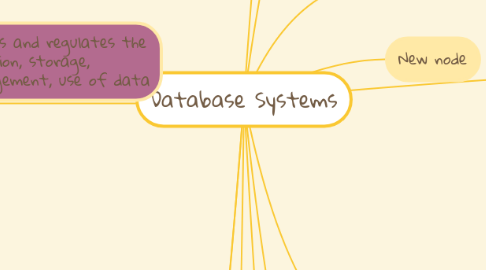
1. defines and regulates the collection, storage, management, use of data
1.1. 5 major parts of a database system
1.1.1. Hardware
1.1.1.1. All the system's physical devices
1.1.2. Software
1.1.2.1. Operating system software
1.1.2.2. DBMS software
1.1.2.3. Application programs and utility software
1.1.3. People
1.1.3.1. System and database administrators
1.1.3.2. Database designers
1.1.3.3. Systems analyst and programmers
1.1.3.4. End users
1.1.4. Data
1.1.4.1. The collection of facts stored in the database
1.1.4.2. New node
1.1.5. Procedures
1.1.5.1. Instructions and rules that govern the design and use of the database system
2. Database management system (DBMS)
2.1. Collection of programs
2.2. Manage structure and control access to data
2.3. The intermediary between the user and the database
2.3.1. Advantages of a DBMS
2.3.1.1. Improved data sharing
2.3.1.2. Improved data security
2.3.1.3. Improved data access
2.3.1.4. Improved decision making
2.3.1.5. Minimized data inconsistency
2.4. Access database through the DBMS
2.5. Enables data to be shared
2.6. Integrates many users' views of the data
3. Data redundancy
3.1. File system structure makes it difficult to combine data from multiple sources
3.2. Organizational structures promotes storage of same data in different locations
3.2.1. Data redundancy
3.2.1.1. Same data stored unnecessarily in different places
3.2.2. Data inconsistency
3.2.2.1. Different and conflicting versions of same data occur at different places
3.2.3. Data anomalies
3.2.3.1. Abnormalities when all changes in redundant data not made correctly
3.2.3.1.1. Update anomalies
3.2.3.1.2. Insertion anomalies
3.2.3.1.3. Deletion anomalies
3.3. Data stored in different locations unlikely to be updates consistently
4. New node
4.1. Shared, integrated computer structure that stores a collection of data
4.2. Metadata
4.2.1. Data about data
4.2.2. Provides description of data characteristics and relationships in data
4.2.3. Complements and expends value of data
5. Data dictionary management
5.1. Stores definitions of data elements and relationships in a data dictionary
5.2. Changes automatically recorded in the dictionary
5.3. Provides data abstraction, removes structural and data dependency
6. The differences between:-
6.1. Data
6.1.1. Raw facts
6.1.2. Formatted for storage, processing and presentation
6.1.3. Building blocks of information
6.2. Information
6.2.1. Result of processing raw data to reveal meaning
6.2.2. Requires context to reveal meaning
6.2.3. Foundation of information
6.2.3.1. Accurate, relevant, timely information is the key to good decision making
6.2.3.1.1. Good decision making is the key to organizational survival
6.2.4. Bedrock of knowledge
6.2.5. Produced by processing data
6.2.6. Reveal meaning in data
7. DBMS functions
7.1. Data storage management
7.1.1. Creates and manages complex structures required for data storage
7.1.2. Performance tuning: activities that make the database perform more efficiently
7.1.3. Stores the database in multiple physical data files
7.2. Data transformation and presentation
7.2.1. Transform data entered to conform to required data structures
7.2.2. Transforms physically retrieved data to conform user's logical expectations
7.3. Security management
7.3.1. Creates a security system that enforces user security and data privacy
7.3.2. Determine which users can access the database, which items can be accessed
7.4. Multiuser access control
7.4.1. Uses sophisticated algorithms to ensure concurrent access does not affect integrity
8. Disadvantages of database systems
8.1. Increased costs
8.2. Management complexity
8.3. Maintaining currency
8.4. Vendor dependence
9. New node
10. Historical Roots: Files and File Systems
10.1. Reasons:
10.1.1. Complexity of database design easier to understand
10.1.2. Understanding file system problems helps to avoid problems with DBMS systems
10.1.3. Knowledge of file system useful for converting file system to database system
10.2. Composes of collection of file holders
10.2.1. Each tagged and kept in cabinet
10.2.2. Organized by expected use
10.3. Content of each file holder logically related
10.4. Manual system served as a data repository for small data collections
10.4.1. Cumbersome for large collections
10.5. Data processing (DP) specialist
10.5.1. Wrote software that managed the data
10.5.2. Designed the application programs
10.6. Number of files increased, file systems evolved
10.6.1. Store, retrieve and modify data
10.6.2. Owned by individual or department that commissioned its creation
10.7. Data processing (DP) manager
11. New node
12. Database
12.1. Shared, integrated computer structure that stores a collection of data
12.1.1. Metadata
12.1.1.1. Data about data
12.1.1.2. Provides description of data characteristics and relationships in data
12.1.1.3. Complements and expands value of data
12.2. Can be classified according to:
12.2.1. Number of users
12.2.2. Database locations
12.2.3. Expected type and extent of use
12.3. Types of database
12.3.1. Single-user database
12.3.1.1. Supports only one user at a time
12.3.1.1.1. Desktop database- single-user, runs on PC
12.3.1.2. New node
12.3.2. Multiuser database
12.3.2.1. Supports multiple users at the same time
12.3.2.1.1. Workgroup database- supports a small number
12.3.2.1.2. Enterprise database- supports a large number
12.3.3. Centralized database
12.3.3.1. Data located at a single site
12.3.3.2. New node
12.3.4. Distributed database
12.3.4.1. Data distributed across several different sites
12.3.5. Operational database
12.3.5.1. Supports a company's day-to-day operations
12.3.5.1.1. Transactional or production database
12.3.6. Data warehouse
12.3.6.1. Stores data used for tactical or strategic decisions
12.3.6.2. New node
12.3.7. New node
12.4. Why database design is important
12.4.1. Focuses on design of database structure used for end-user data
12.4.2. Well-designed database
12.4.2.1. Facilitates data management
12.4.2.2. Generates accurate and valuable information
12.4.3. Poorly designed database
12.4.3.1. Causes difficult-to-trace errors

